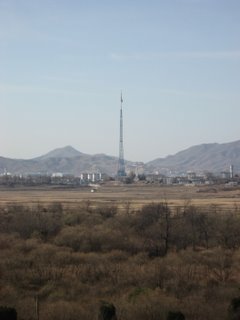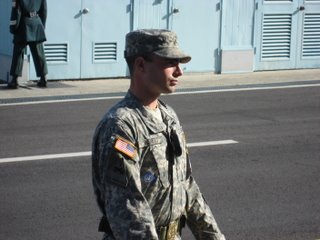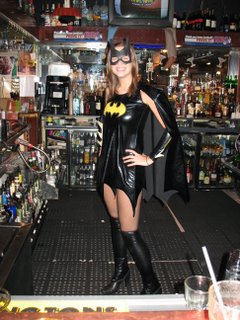DMZ a la Wikipedia
Here's a little info on the DMZ courtesy of the fine folks at Wikipedia. They're not kidding when they say it's a tense environment!History

The 38th parallel north — which cuts the Korean Peninsula roughly in half — was the original boundary between the U.S.-controlled and Soviet-controlled areas of Korea at the end of World War II. Upon the creation of the Democratic People's Republic of Korea and the Republic of Korea in 1948, it became a de facto international border and one of the tensest fronts in the Cold War.
Both the North and the South remained heavily dependent on their sponsor states — the Soviet Union and the United States, respectively — from 1948 through the outbreak of the Korean War. The devastating conflict, which went on to claim over three million lives and saw the Korean Peninsula effectively divided along ideological lines, commenced in 1950 with a Soviet-sponsored DPRK invasion across the DMZ, and ended in 1953 after Chinese intervention pushed the front of the war back near the 38th parallel. In the ceasefire of July 27, 1953, the DMZ was created as each side agreed in the armistice to move their troops back 2,000 meters from the front line, creating a buffer zone four kilometres wide. The Military Demarcation Line (MDL) goes right down the center of the DMZ and indicates exactly where the front was when the agreement was signed. The armistice agreement was never followed by a peace treaty and technically the two Koreas are still at war.
Owing to this theoretical stalemate, and genuine hostility between the North and the South, large numbers of troops are still stationed along both sides of the line, each side guarding against potential aggression from the other side. The armistice agreement explains exactly how many military personnel and what kind of weapons are allowed in the DMZ itself. Soldiers from both sides do patrols inside the DMZ, but they may not cross the MDL.
Joint Security Area
Inside the DMZ, near the western coast of the peninsula, is a place called Panmunjeom, home of the Joint Security Area. Here is the only place where North and South connect.
There are a number of buildings on both the north and the south side of the MDL, and a few which are built right on top of the MDL. The Joint Security Area is the location where all negotiations since 1953 have been held, including a number of statements of Korean solidarity, which have generally amounted to little except a slight decline of tensions. The MDL goes right through the conference rooms, right down the middle of the conference tables where the North Koreans and the United Nations Command (primarily South Koreans and Americans) meet face to face.
Though generally calm, the DMZ has been the scene of much sabre-rattling between the two Koreas over the years. A number of small skirmishes have occurred within the Joint Security Area since 1953. The Axe Murder Incident in August 1976 involved the attempted chopping down of a poplar tree which resulted in two deaths and Operation Paul Bunyan. Before this time, the soldiers of both sides were permitted to go back and forth across the MDL inside of the JSA. That stopped as a result of this incident.
Another incident occurred later when a Soviet dignitary, who was part of an official trip to the JSA (hosted by the North), ran across the MDL yelling that he wanted to defect. North Korean troops opened fire and chased him across the line. South Korean troops, protecting the defector, fired back and eventually surrounded the North Koreans. One South Korean soldier was killed in the incident. The defector expressed joy in his successful attempt, but was saddened by the loss of life. Since this incident, the North Korean soldiers face one another so defectors cannot come upon them from behind. They are ordered to shoot anyone who attempts to defect before they get to the line.
Villages in the Demilitarized Zone
Within the DMZ there are two villages: one run by the North and the other by the South. Daeseong-dong, found on the southern side of the DMZ, is a traditional village and strictly controlled by the South Korean government. For instance, one must have ancestral connections to the village in order to live there. These restrictions serve to keep the population of the village very small. In the North, Gijeong-dong, or as it is called in North Korea, "Peace Village" has only a small caretaker population. Through the armistice agreement the North felt t
 hat it should be allowed a town within the borders of the DMZ since the South already had one. UN troops call this Propaganda Village because only a small group of people cleaning and turning on lights reside within the village. Although from afar it appears to be a modern village, one can tell with binoculars that there is no glass within the windows of the buildings. In the past, North Korean propaganda was sent out by loudspeaker across to Daeseong-dong for as much as 20 hours a day, and reciprocal pop music and South Korean exhortations blasted back. These broadcasts ceased by mutual agreement in 2004.
hat it should be allowed a town within the borders of the DMZ since the South already had one. UN troops call this Propaganda Village because only a small group of people cleaning and turning on lights reside within the village. Although from afar it appears to be a modern village, one can tell with binoculars that there is no glass within the windows of the buildings. In the past, North Korean propaganda was sent out by loudspeaker across to Daeseong-dong for as much as 20 hours a day, and reciprocal pop music and South Korean exhortations blasted back. These broadcasts ceased by mutual agreement in 2004.During the 1980s, the South Korean government built a 98.4 metre (328 ft) tall flagpole in Daeseong-dong. The North Korean government responded by building a taller one — the tallest in the world at 157.5 metres (525 ft) - in Gijeong-dong. The North Korean flag at the top weighs around 270 kg (675 lb) when dry and must be taken down the instant it starts raining, as the tower cannot support its weight when it is wet.
Propaganda

Tourists visiting the southern side of the JSA have sometimes been told (by U.S. soldiers serving as tour guides) that the North Korean building facing South Korea is not a real building but, "a façade designed to look large and impressive, in reality only a frame a few feet (1m) thick." However, accounts from tourists having visited the northern side of the JSA have confirmed that it is a real building.
Propaganda in the North has stated that the U.S. and South Korea have built a massive unclimbable wall across the entire length of the DMZ (the Korean wall). Upon the collapse of the Berlin Wall, propagandists in the North seized upon its value and proclaimed this huge system of fencing and tank barriers to be a wall equivalent to the one in Berlin. Signs on the Northern side describe the ceasefire like this:
It was here on July 27, 1953 that the American imperialists got down on their knees before the heroic Chosun people to sign the ceasefire for the war they had provoked June 25, 1950.

3 Comments:
Who inspired the essay? Was it me?
Beaks
That's quite was an experience. Not sure I'd have been all that comfortable though.
cool write up
댓글 쓰기
<< Home